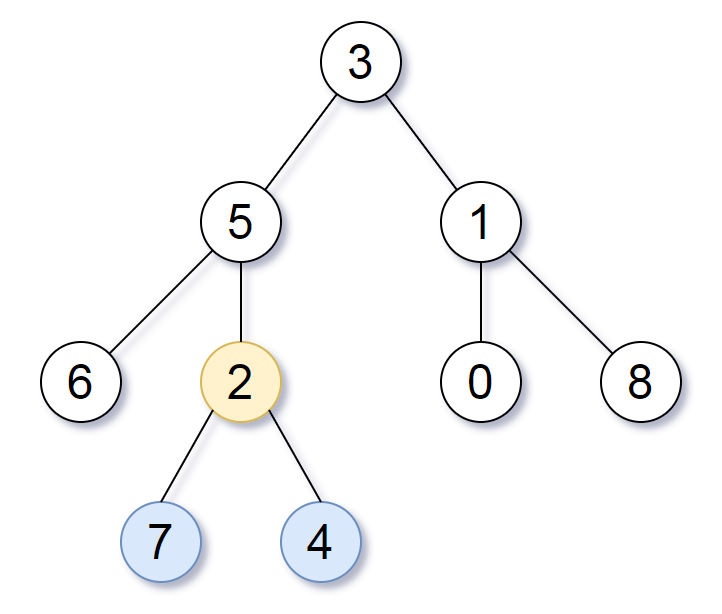
Given the root of a binary tree, return the lowest common ancestor of its deepest leaves.
Recall that:
- The node of a binary tree is a leaf if and only if it has no children
- The depth of the root of the tree is 0. if the depth of a node is d, the depth of each of its children is d + 1.
- The lowest common ancestor of a set S of nodes, is the node A with the largest depth such that every node in S is in the subtree with root A.
1
2
3
4
5
6
7
| Example 1:
Input: root = [3,5,1,6,2,0,8,null,null,7,4]
Output: [2,7,4]
Explanation: We return the node with value 2, colored in yellow in the diagram.
The nodes coloured in blue are the deepest leaf-nodes of the tree.
Note that nodes 6, 0, and 8 are also leaf nodes, but the depth of them is 2, but the depth of nodes 7 and 4 is 3.
|

1
2
3
4
5
| Example 2:
Input: root = [1]
Output: [1]
Explanation: The root is the deepest node in the tree, and it's the lca of itself.
|
1
2
3
4
5
| Example 3:
Input: root = [0,1,3,null,2]
Output: [2]
Explanation: The deepest leaf node in the tree is 2, the lca of one node is itself.
|
Constraints:
- The number of nodes in the tree will be in the range [1, 1000].
- 0 <= Node.val <= 1000
- The values of the nodes in the tree are unique.
Solution#
1
2
3
4
5
6
7
8
9
10
11
12
13
14
15
16
17
18
19
20
21
22
23
24
25
26
27
28
29
30
31
32
33
34
35
36
37
38
39
40
41
42
| /**
* Definition for a binary tree node.
* public class TreeNode {
* int val;
* TreeNode left;
* TreeNode right;
* TreeNode() {}
* TreeNode(int val) { this.val = val; }
* TreeNode(int val, TreeNode left, TreeNode right) {
* this.val = val;
* this.left = left;
* this.right = right;
* }
* }
*/
class Solution {
int max = 0;
TreeNode lca = null;
public TreeNode lcaDeepestLeaves(TreeNode root) {
deepest(root, 0);
return lca;
}
int deepest(TreeNode node, int level) {
if (node == null) return 0;
if (level > max) {
max = level;
lca = node;
}
int leftMax = deepest(node.left, level + 1);
int rightMax = deepest(node.right, level + 1);
if (leftMax == max && rightMax == max) {
lca = node;
}
return Math.max(level, Math.max(leftMax, rightMax));
}
}
|
